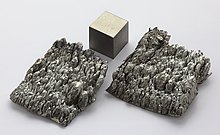
Back Skandium AF ስካንዲየም AM Escandio AN स्कैंडियम ANP سكانديوم Arabic سكانديوم ARY سكانديوم ARZ Escandiu AST स्क्यान्डियम AWA Skandium AZ
 | ||||||||||||||||||||||||||||||||||||||||||||||
| Scandium | ||||||||||||||||||||||||||||||||||||||||||||||
|---|---|---|---|---|---|---|---|---|---|---|---|---|---|---|---|---|---|---|---|---|---|---|---|---|---|---|---|---|---|---|---|---|---|---|---|---|---|---|---|---|---|---|---|---|---|---|
| Pronunciation | /ˈskændiəm/ | |||||||||||||||||||||||||||||||||||||||||||||
| Appearance | silvery white | |||||||||||||||||||||||||||||||||||||||||||||
| Standard atomic weight Ar°(Sc) | ||||||||||||||||||||||||||||||||||||||||||||||
| Scandium in the periodic table | ||||||||||||||||||||||||||||||||||||||||||||||
| ||||||||||||||||||||||||||||||||||||||||||||||
| Atomic number (Z) | 21 | |||||||||||||||||||||||||||||||||||||||||||||
| Group | group 3 | |||||||||||||||||||||||||||||||||||||||||||||
| Period | period 4 | |||||||||||||||||||||||||||||||||||||||||||||
| Block | d-block | |||||||||||||||||||||||||||||||||||||||||||||
| Electron configuration | [Ar] 3d1 4s2 | |||||||||||||||||||||||||||||||||||||||||||||
| Electrons per shell | 2, 8, 9, 2 | |||||||||||||||||||||||||||||||||||||||||||||
| Physical properties | ||||||||||||||||||||||||||||||||||||||||||||||
| Phase at STP | solid | |||||||||||||||||||||||||||||||||||||||||||||
| Melting point | 1814 K (1541 °C, 2806 °F) | |||||||||||||||||||||||||||||||||||||||||||||
| Boiling point | 3109 K (2836 °C, 5136 °F) | |||||||||||||||||||||||||||||||||||||||||||||
| Density (near r.t.) | 2.985 g/cm3 | |||||||||||||||||||||||||||||||||||||||||||||
| when liquid (at m.p.) | 2.80 g/cm3 | |||||||||||||||||||||||||||||||||||||||||||||
| Heat of fusion | 14.1 kJ/mol | |||||||||||||||||||||||||||||||||||||||||||||
| Heat of vaporization | 332.7 kJ/mol | |||||||||||||||||||||||||||||||||||||||||||||
| Molar heat capacity | 25.52 J/(mol·K) | |||||||||||||||||||||||||||||||||||||||||||||
Vapor pressure
| ||||||||||||||||||||||||||||||||||||||||||||||
| Atomic properties | ||||||||||||||||||||||||||||||||||||||||||||||
| Oxidation states | 0,[3] +1,[4] +2,[5] +3 (an amphoteric oxide) | |||||||||||||||||||||||||||||||||||||||||||||
| Electronegativity | Pauling scale: 1.36 | |||||||||||||||||||||||||||||||||||||||||||||
| Ionization energies |
| |||||||||||||||||||||||||||||||||||||||||||||
| Atomic radius | empirical: 162 pm | |||||||||||||||||||||||||||||||||||||||||||||
| Covalent radius | 170±7 pm | |||||||||||||||||||||||||||||||||||||||||||||
| Van der Waals radius | 211 pm | |||||||||||||||||||||||||||||||||||||||||||||
| Other properties | ||||||||||||||||||||||||||||||||||||||||||||||
| Natural occurrence | primordial | |||||||||||||||||||||||||||||||||||||||||||||
| Crystal structure | hexagonal close-packed (hcp) (hP2) | |||||||||||||||||||||||||||||||||||||||||||||
| Lattice constants | a = 330.89 pm c = 526.80 pm (at 20 °C)[6] | |||||||||||||||||||||||||||||||||||||||||||||
| Thermal expansion | α, poly: 10.2 µm/(m⋅K) (at r.t.) | |||||||||||||||||||||||||||||||||||||||||||||
| Thermal conductivity | 15.8 W/(m⋅K) | |||||||||||||||||||||||||||||||||||||||||||||
| Electrical resistivity | α, poly: 562 nΩ⋅m (at r.t., calculated) | |||||||||||||||||||||||||||||||||||||||||||||
| Magnetic ordering | paramagnetic | |||||||||||||||||||||||||||||||||||||||||||||
| Molar magnetic susceptibility | +315.0×10−6 cm3/mol (292 K)[7] | |||||||||||||||||||||||||||||||||||||||||||||
| Young's modulus | 74.4 GPa | |||||||||||||||||||||||||||||||||||||||||||||
| Shear modulus | 29.1 GPa | |||||||||||||||||||||||||||||||||||||||||||||
| Bulk modulus | 56.6 GPa | |||||||||||||||||||||||||||||||||||||||||||||
| Poisson ratio | 0.279 | |||||||||||||||||||||||||||||||||||||||||||||
| Brinell hardness | 736–1200 MPa | |||||||||||||||||||||||||||||||||||||||||||||
| CAS Number | 7440-20-2 | |||||||||||||||||||||||||||||||||||||||||||||
| History | ||||||||||||||||||||||||||||||||||||||||||||||
| Naming | after Scandinavia | |||||||||||||||||||||||||||||||||||||||||||||
| Prediction | Dmitri Mendeleev (1871) | |||||||||||||||||||||||||||||||||||||||||||||
| Discovery and first isolation | Lars Fredrik Nilson (1879) | |||||||||||||||||||||||||||||||||||||||||||||
| Isotopes of scandium | ||||||||||||||||||||||||||||||||||||||||||||||
| ||||||||||||||||||||||||||||||||||||||||||||||
Scandium is a chemical element; it has symbol Sc and atomic number 21. It is a silvery-white metallic d-block element. Historically, it has been classified as a rare-earth element,[9] together with yttrium and the lanthanides. It was discovered in 1879 by spectral analysis of the minerals euxenite and gadolinite from Scandinavia.[10]
Scandium is present in most of the deposits of rare-earth and uranium compounds, but it is extracted from these ores in only a few mines worldwide. Because of the low availability and difficulties in the preparation of metallic scandium, which was first done in 1937, applications for scandium were not developed until the 1970s, when the positive effects of scandium on aluminium alloys were discovered. To this day, its use in such alloys remains its only major application. The global trade of scandium oxide is 15–20 tonnes per year.[11]
The properties of scandium compounds are intermediate between those of aluminium and yttrium. A diagonal relationship exists between the behavior of magnesium and scandium, just as there is between beryllium and aluminium. In the chemical compounds of the elements in group 3, the predominant oxidation state is +3.
- ^ "Standard Atomic Weights: Scandium". CIAAW. 2021.
- ^ Prohaska, Thomas; Irrgeher, Johanna; Benefield, Jacqueline; Böhlke, John K.; Chesson, Lesley A.; Coplen, Tyler B.; Ding, Tiping; Dunn, Philip J. H.; Gröning, Manfred; Holden, Norman E.; Meijer, Harro A. J. (2022-05-04). "Standard atomic weights of the elements 2021 (IUPAC Technical Report)". Pure and Applied Chemistry. doi:10.1515/pac-2019-0603. ISSN 1365-3075.
- ^ Cloke, F. Geoffrey N.; Khan, Karl & Perutz, Robin N. (1991). "η-Arene complexes of scandium(0) and scandium(II)". J. Chem. Soc., Chem. Commun. (19): 1372–1373. doi:10.1039/C39910001372.
- ^ Smith, R. E. (1973). "Diatomic Hydride and Deuteride Spectra of the Second Row Transition Metals". Proceedings of the Royal Society of London. Series A, Mathematical and Physical Sciences. 332 (1588): 113–127. Bibcode:1973RSPSA.332..113S. doi:10.1098/rspa.1973.0015. S2CID 96908213.
- ^ McGuire, Joseph C.; Kempter, Charles P. (1960). "Preparation and Properties of Scandium Dihydride". Journal of Chemical Physics. 33 (5): 1584–1585. Bibcode:1960JChPh..33.1584M. doi:10.1063/1.1731452.
- ^ Arblaster, John W. (2018). Selected Values of the Crystallographic Properties of Elements. Materials Park, Ohio: ASM International. ISBN 978-1-62708-155-9.
- ^ Weast, Robert (1984). CRC, Handbook of Chemistry and Physics. Boca Raton, Florida: Chemical Rubber Company Publishing. pp. E110. ISBN 0-8493-0464-4.
- ^ Kondev, F. G.; Wang, M.; Huang, W. J.; Naimi, S.; Audi, G. (2021). "The NUBASE2020 evaluation of nuclear properties" (PDF). Chinese Physics C. 45 (3): 030001. doi:10.1088/1674-1137/abddae.
- ^ "IUPAC Recommendations, Nomenclature of Inorganic Chemistry" (PDF). Archived from the original (PDF) on 2008-05-27.
- ^ Samson, Iain M.; Chassé, Mathieu (2016), "Scandium", in White, William M. (ed.), Encyclopedia of Geochemistry: A Comprehensive Reference Source on the Chemistry of the Earth, Cham: Springer International Publishing, pp. 1–5, doi:10.1007/978-3-319-39193-9_281-1, ISBN 978-3-319-39193-9, retrieved 2023-02-01
- ^ "Mineral Commodity Summaries 2020" (PDF). US Geological Survey Mineral Commodities Summary 2020. US Geological Survey. Retrieved 10 February 2020.
